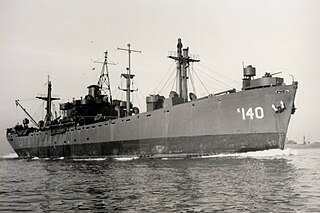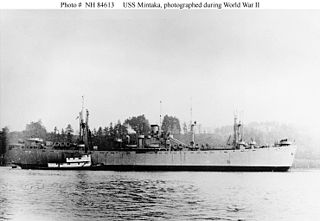
USS Naos (AK-105) was a Crater-class cargo ship commissioned by the US Navy for service in World War II. Naos was named after the star Naos, in the constellation Puppis. She was responsible for delivering troops, goods and equipment to locations in the Asiatic-Pacific Theater.

USS Situla (AK-140) was a Crater-class cargo ship in the service of the United States Navy in World War II. It was the only ship of the Navy to have borne this name. It is named after the star Situla.

USS Cheleb (AK-138) was a Crater-class cargo ship in the service of the US Navy in World War II. It was the only ship of the Navy to have borne this name. It is named after Cheleb, a star in the northern hemisphere constellation of Ophiuchus.
USS Prince Georges (AP-165/AK-224) was a Crater-class cargo ship in the service of the US Navy in World War II. Named after the Prince George's County, Maryland, it was the only ship of the Navy to bear this name.

USS Mintaka (AK-94) was a Crater-class cargo ship commissioned by the US Navy for service in World War II. She was named after Mintaka, a star in the Orion constellation. Mintaka was crewed by United States Coast Guard personnel and was responsible for delivering troops, goods and equipment to locations in the Asiatic-Pacific Theater.

USS Allioth (AK-109/IX-204/AVS-4) was a Crater-class cargo ship commissioned by the US Navy for service in World War II, named after Alioth, a star in constellation Ursa Major. She was responsible for delivering troops, goods and equipment to locations in the war zone.
USS Alkaid (AK-114) was a Crater-class cargo ship, converted from a Liberty Ship, commissioned by the US Navy for service in World War II. She was first named after William G. Sumner, a classical liberal American social scientist. She was renamed and commissioned after Alkaid, a star in the Big Dipper asterism or constellation Ursa Major. She was responsible for delivering troops, goods and equipment to locations in the war zone.

USS Shaula (AK-118) was a Crater-class cargo ship, converted from a Liberty Ship, commissioned by the US Navy for service in World War II. She was first named after James Screven, an American general during the American Revolutionary War. She was renamed and commissioned after Shaula, the second-brightest star system in the constellation of Scorpius. She was responsible for delivering troops, goods and equipment to locations in the war zone.

USS Sabik (AK-121) was a Crater-class cargo ship commissioned by the U.S. Navy for service in World War II. She was responsible for delivering troops, goods and equipment to locations in the war zone.

USS Menkar (AK-123) was a Crater-class cargo ship, converted from a Liberty Ship, commissioned by the U.S. Navy for service in World War II. She was first named after John White, a settler among those who sailed with Richard Grenville, to present-day North Carolina, in 1585, to found the Roanoke Colony. White acted as artist and mapmaker to the expedition. He became the governor, in 1587, of the colony, and his granddaughter, Virginia Dare, was the first English child born in the Americas. She was renamed and commissioned after Menkar, the second-brightest star in the constellation of Cetus. She was responsible for delivering troops, goods and equipment to locations in the war zone.

USS Azimech (AK-124) was a Crater-class cargo ship commissioned by the US Navy for service in World War II, named after the Azimech, the other name of Spica, the brightest star in constellation Virgo. She was responsible for delivering troops, goods and equipment to locations in the war zone.

USS Lesuth (AK-125) was a Crater-class cargo ship commissioned by the US Navy for service in World War II. Lesuth was named after the star Lesuth in the constellation Scorpius. She was responsible for delivering troops, goods and equipment to locations in the Asiatic-Pacific Theater.

USS Megrez (AK-126) was a Crater-class cargo ship commissioned by the US Navy for service in World War II. Megrez was named after Megrez, a star in the constellation Ursa Major. She was responsible for delivering troops, goods and equipment to locations in the Asiatic-Pacific Theater.

USS Phobos (AK-129) was a Crater-class cargo ship commissioned by the U.S. Navy for service in World War II. She was responsible for delivering troops, goods and equipment to locations in the war zone.

USS Ascella (AK-137) was a Crater-class cargo ship commissioned by the US Navy for service in World War II. Ascella was named after Ascella, a star in the constellation Sagittarius. She was responsible for delivering troops, goods and equipment to locations in the Asiatic-Pacific Theater.

USS Kochab (AKS-6) was an Acubens-class general stores issue ship commissioned by the U.S. Navy for service in World War II. She was responsible for delivering and disbursing goods and equipment to locations in the war zone. The vessel was constructed by Delta Shipbuilding Co. of New Orleans, Louisiana, and launched on 8 March 1944 under a Maritime Commission contract. After being acquired the U.S. Navy, the vessel was converted into a general stores ship and entered service on 4 November 1944. Kochab supported American operations in the Pacific Theater, sailing between US bases on Pacific islands. Following the war's end, Kochab sailed to the US with returning personnel and operated along the United States West Coast before being decommissioned on 17 April 1946. The vessel was then placed in reserve. Kochab was sold for scrap in 1965.
USS Volans (AKS-9) was an Acubens-class general stores issue ship commissioned by the U.S. Navy for service in World War II. She was responsible for delivering and disbursing goods and equipment to locations in the war zone.

USS Kern (AOG-2) was a Patapsco-class gasoline tanker acquired by the United States Navy for the dangerous task of transporting gasoline to warships in the fleet, and to remote Navy stations.

USS McCracken (APA-198) was a Haskell-class attack transport acquired by the U.S. Navy during World War II for the task of transporting troops to and from combat areas.

USS Boulder Victory (AK-227) was a Boulder Victory-class cargo ship acquired by the US Navy during World War II. She was the lead ship of 20 ships in her class. She carried ammunition into the Pacific Ocean war zone and, on 20 December 1944 at Manus Island, New Guinea, she struck a naval mine and suffered a very large hole in her side.


















